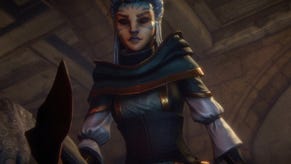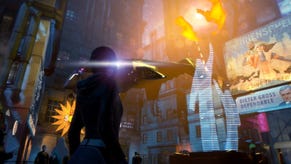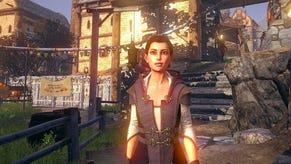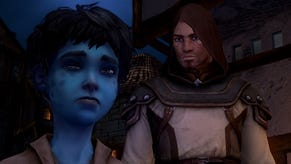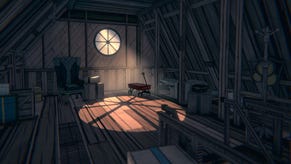Journey's End: Dreamfall Chapters Interview - Part One
Dream a little dream
Ragnar Tørnquist founded Red Thread Games with one immediate goal in mind: to finish the story he has been telling for a great part of his adult life. As this interview is published, the Kickstarter for Dreamfall Chapters went live a couple of minutes ago. In readiness, I had a long conversation with Tørnquist, Dreamfall co-writer Dag Scheve and lead designer Martin Bruusgaard earlier this week. The studio is new, the premises are new, but the team are old friends and Dreamfall veterans. In this first part of the interview, we talked about cold hard cash, going indie, Kickstarter and the state of the industry.
Bruusgaard arrives, late, having been sent to find a cable.
RPS: I’ll start by asking where that cable was hiding.
Tørnquist: That’s actually something we had to borrow from the neighbours. We were trying to locate a projector – we have a Kickstarter party happening tomorrow, where we have invited Norwegian gaming press, and some fans, friends and colleagues. We’re going to do that at the bar downstairs. It’s very convenient that we have a bar downstairs.
Scheve: It’s a nice bar too!
Tørnquist: It is a nice bar. We have about a hundred people coming to basically get a presentation of the Kickstarter and to give them an idea of what this is all about. In Norway, it [Kickstarter] is not very well known. So, for the projector, Martin is actually borrowing cables from the neighbours. And that is exactly how we operate in a way. We’re tiny. We don’t have a lot of money, we don’t have a lot of resources. We don’t really have any titles either, we just do whatever…
Scheve: We do what we can and what we want.
Tørnquist: Exactly. We all kind of chip in. We’d like to avoid having titles if necessary. We’ll still have roles, of course, but we try to keep it flat and with a 'do it yourself' mentality.
RPS: You’re socialists of some sort.
Tørnquist: We’re Norwegians, what do you expect!
RPS: Are you settled in the studio now, with the team back together?
Tørnquist: Yes, we are. We haven’t actually revealed who the artists are [they have now] but I don’t mind telling you because you’re still under embargo! The artists are all basically the Dreamfall veterans and these are guys who worked with us for so many years. They left Funcom a couple of years back. This includes Christer Sveen, the art director on Dreamfall and a couple of the technical guys on the art side.
It’s the whole core art team from Dreamfall. Just walking down the hall here and chatting with them it’s like we’re back in 2004. It’s really strange actually. We’re working in the same universe, with the same people.
Scheve: Except it looks so much better now.
Tørnquist: It feels like coming home. Not that Funcom wasn’t home, but that’s sort of a phase that’s behind most of us now. This is a new home and it feels very cosy.
Bruusgaard: For me it’s a very recent feeling. We have been talking about it for a little while but I had my first day on the job on Friday. For me, it feels amazing, coming from what I joked about was a grown-up job and now coming back into the industry, it feels great. I notice when I’m at home as well, I’m so much more motivated and happy. It feels good to be back with the people I’ve worked with before and we’re all friends and making something awesome together. It feels really good.
Scheve: It does feel great. I have nothing to add. (laughs)
Tørnquist: This feels like something we can settle into and do for a very long time.
RPS: Where is the strangest place you’ve found an old member of the team? How many were still in the industry?
Tørnquist: We found somebody in the gutter.
RPS: Was that Martin?
Bruusgaard: Hey!
Tørnquist: That would be a great montage sequence, finding the Dreamfall team members – picking one out of a wrestling match in Mexico, one is a beach boy in Coco Cabana. I can see the montage now.
No, it was much more boring than that. I knew that half the team, the art guys, were working their own company and had their own projects, but they were extremely interested in getting back together and working on this. A lot of the people at Funcom also got laid off after The Secret World launched – things didn’t go as well as they were supposed to – and at that point, I knew that I needed to grab those guys straight away before they started successful careers in other industries, or went to LA as you were planning on doing and becoming a soap star!
Bruusgaard: (laughs)
Tørnquist: So it was a matter of striking while the time was right and grabbing a lot of these key people and making a company to make this project. So unfortunately, no montage travelling around the world, but that should have been our Kickstarter video. Travelling around and finding team members.
RPS: We spoke about Kickstarter a year or so back, Ragnar, as something that was changing things. How do you think things have changed since then and would this studio be possible without Kickstarter?
Tørnquist: No. It wouldn’t be. If our Kickstarter fails, which could happen, we’ll still strive to make Dreamfall Chapters in some other way, but Kickstarter is the catalyst. It changes everything. It’s at the cusp of so many small changes and it’s fantastic. Everythign from new platforms to new distribution models, that began with Steam and the App Store, and then Kickstarter and the fall of the great publishers, which we’re entering now. The re-emergence of PC as the key, core platform.
Scheve: Changes in retail as well.
Tørnquist: Most of the retail business is disappearing. HMV closing. Everything is happening right now and it’s a fantastic time to be in game development. IT sounds callous almost, and cruel to say it, but it’s a great time. Lots of people are losing their jobs but every industry has to go through this sea change and this time we’re in now is the best thing that’s ever happened to gaming. Seriously,because it’s empowering creators and the smaller studios, the smaller actors can enter and create work and get their word out. You don’t need the huge publishing machines and distribution models behind you. Things are starting to happen. Steam Box will hopefully be huge and I think we’re facing the final generation of traditional consoles. Everything is happening.
Scheve: There are so many new kinds of game and new stories coming about. I mean, we’re doing a sequel… (laughs)
Tørnquist: But it doesn’t have to be! There’s room to experiment.
Bruusgaard: People are open to playing games in completely new ways and exploring mechanics in new ways.
Tørnquist: Games are now the most interesting artform, beyond anything. Movies are not going through any sea changes…
RPS: 3D!
Tørnquist: Exactly. TV is not doing it. Fine art, in general, isn’t facing the same change. Although I do think Kickstarter will have a stronger effect on other artforms and other types of media. I don’t think they’ve gotten there quite yet. Games is where it’s at right now, it’s where the most interesting things are happening.
Scheve: That’s where the biggest Kickstarter projects are. I imagine there will be more forms of entertainment going to Kickstarter.
Tørnquist: There are, but they’re usually smaller.
RPS: I haven’t personally seen, say, a million dollar film project. I’ve seen shorts on Kickstarter, smaller projects.
Tørnquist: It might catch on, but right now games is where it’s at with experimentation in terms of exploring an artform and a medium.
Bruusgaard: Dubstep has revolutionised the industry.
RPS: The game trailer industry. Do you think there’s the possibility that if Chapters is a huge success we fall into a cycle where the big publishers say, ‘aha, adventure games are back’ and they invite you back on board?
Tørnquist: Maybe, but would we want that? If we can survive doing this, there’s so much for us to gain. We get to control what we’re making, to make our own games, to be in full creative control. And we get to reap the benefits if the games are successful and control our own destinies. I really have no desire to get back into big budget, studio system work at all. I’m enjoying this – having to go next door to get a cable. Or having somebody do that, because I have people to do that for me!
RPS: I thought you said there were no titles.
Tørnquist: There is a hierarchy though. (laughs) But part of this is having to do the most seemingly mundane things. Like, I did work on the website for our company. That’s not my job – it’s not what I’m good at, I should say, but it is my job.
The other aspect is to see every dollar rolling in going into our future games and not into the pockets of investors or distrubitors or people who haven’t really worked on it. Everything that comes from this game goes back to the people who made it. And that makes a big difference and I’m willing to do a lot to maintain that, and I think that’s true of a lot of people who are leaving the studio system.
Last year was an exodus from the studio system. Everybody left! Either to do something else, like brewing beer or travel the world, to be a playboy, but a lot of people leave to go into indie development. And this is the time to do that. People are tired of working in the old system.
RPS: But do you think the experiences of the last six years have helped you? Do you have skills now that you didn’t have and do you think Chapters will be a stronger game than it would have been if you’d gone straight into it?
Scheve: Most definitely, yes. We learned so much about different ways of telling stories with TSW. The great thing about that game for me was about telling many stories in a universe, with so many characters, and the way we experimented with the format for storytelling purposes with the investigation missions.
Tørnquist: And also from a production point of view as well. The MMO genre is the hardest one to work in. If you’ve done an MMO, you’ve done it all. And to be able to say that we managed to get through that and to actually make a game that we’re proud of and that we’re very happy we worked on, it has given us so much knowledge. How do you feel, Martin?
Bruusgaard: As you said, when you do an MMO, you’ve done it all.
Tørnquist: And you’ve done two!
Bruusgaard: It’s so complex. I think we all bring different elements from that experience into this company. We all had different parts to play and explored different possibilities, and I think we’re all clever enough to learn from what we did – the good and the bad – and to take that and move forward.
RPS: Before we move on to talking about the game, I was wondering about budgets. You may not have figures, but do you know the difference between the budget you’re aiming for here and the budget for the previous games?
Tørnquist: I actually just did a calculation on that earlier today. These are not super exact numbers because I don’t remember and don’t have the spreadsheets. But I think Dreamfall cost between 5 and 6 million dollars, and Longest Journey cost about half of that. Maybe a little bit more. We’re asking for $850,000 on Kickstarter but that’s not the entire budget for the game. We put our own money into it and we’re getting some government grants and some other sources of money. They are completely unrelated to publishers – being a socialist country helps us out quite a bit – but there are lots of ways for us to get a little bit of money here and there. It’s over a million dollars but definitely not close to the budget of Dreamfall.
The reason for that is not that we were wasteful. The first thing is that we’re using a well established and very good engine now – Unity. On Dreamfall we did have a licensed engine but it was shit and we had to do everything in order to make it work.
Scheve: Just to make tools took so much programming.
Tørnquist: And we had to make an XBOX version, which was really hard because we had to squeeze a PC game into an XBOX and had no knowledge of how to do that at all. It was a miracle that we managed to do it, thanks to one person’s expertise actually. We also had a team of about 30 people on Dreamfall by the end and, again, that team could have been smaller if we’d had more experience. Right now we’re able to do ten times as many animations with one third of the animators simply because we’re doing it more smartly. We have artists who have been working in the industry for twenty years. They know exactly how to build something and we have a lot more experience with the design – we’re not experimenting in terms of production.
Scheve: And the artists have worked in the Unity engine for a couple of years since leaving Funcom, so they know their way around it.
Tørnquist: So this is why we’re able to make a game a lot cheaper than with Dreamfall, and a game that is better looking and as big, or at least that’s our ambition. Everything we show is realtime in-game.
Scheve: If you remember from Dreamfall, you can see that we’ve used some of the same assets and we have access to those which helps us.
Tørnquist: Although we are definitely refurbishing everything.
Scheve: Yes, but we don’t have to model them from the ground up.
Tørnquist: Yeah. The characters are completely rebuilt though. We’re taking a real step up there to tell the story better.
RPS: And that’s a good segueway into story, so I shall jump on it.
The Dreamfall Chapters Kickstarter is live now. There will be much more to read this weekend as the interview continues. We follow the thread into story, where we discuss returning characters, new faces, and how best to balance the mundane and the magical. And yet more - it wouldn't be a full overview if I didn't ask about whether there's pointing and clicking in this third person adventure, whether the new mechanics include any combat (short answer: they don't) and the most important question of all: 'if COD is a man-shooter, how would you describe Dreamfall Chapters'?






